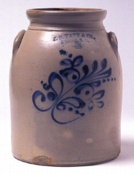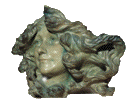terra cotta
or
terracotta or terra-cotta - A reddish-brown clay that can be used much as other ceramic clays, fired after it is formed and dried, and often used
for pottery, sculpture
and architectural decoration. Its reddish-brown color results from its iron-oxide content.
In contrast, unbaked clay is called
terra cruda.
Examples:
Egypt, c. 3500-3100 BCE (Nagada II), Vase, painted terra cotta, 20.5 x 15.5 cm, Louvre. See Egyptian art.
Attributed to Douris (Greek, Athenian, first half of the fifth century BC), Atalanta Lekythos, painted white-ground terra cotta, 500-490 BCE, height 31.8 cm, Cleveland Museum of Art. See Greek art and lekythos.
![]()
Etruscan, early 400s BCE,
Antefix, terra cotta, 21 7/16 x 12 3/4
x 6 1/2 inches (54.6 x 32.5 x 16.5 cm), J. Paul Getty Museum,
Malibu, CA. A silenos and maenad dance
in a Dionysiac revel on this Etruscan
antefix. See mythology.
![]()
Greece, Apulia, South Italy, attributed
to the Painter of Louvre MNB 1148, about 330 BCE,
Red-Figure Loutrophoros (Type I) with Ovoid Body,
terra cotta, height 35 1/2
inches, diameter (rim)
10 1/2 inches (h. 90.1 cm, d. 26.0 cm), J. Paul Getty Museum,
Malibu, CA. See Greek
art.
![]()
Greek (Seleucid or Ptolemaic), 2nd century
BCE,
Faience Alabastron, glazed terra cotta,
9 1/16 inches (23 cm), J. Paul Getty Museum, Malibu, CA. See
faience.

Andrea Della Robbia (Italian, Florence,
1435-1525), Virgin, from The Annunciation,
c. 1475-80, lead glazed
terra cotta, height 56 inches
(165.1 cm), (other figures — Archangel Gabriel God the Father,
Dove of the Holy Spirit — not illustrated). Los Angeles County
Museum of Art.

Gianlorenzo Bernini (Italian, 1598-1680), Angel Holding the Superscription (Standing Angel with Scroll),
1667-68, terra cotta, 29.2 cm, Fogg Art Museum, Harvard U, MA.
The "superscription" is the notice (sometimes called
a titulus) reading "INRI" posted over the head
of Christ when crucified. These initials stand for the Latin
words for "Jesus of Nazareth, King of the Jews." See angel, Baroque, crucifix,
inscription, and scroll.
![]()
Claude Michel, "Clodion" (French,
1738-1814), Vestal Presenting a Young Woman at the Altar
of Pan, about 1770-1775, terra cotta, height
excluding base 17 3/4 inches
(45 cm), J. Paul Getty Museum, Malibu, CA.

Jean-Antoine Houdon (French, 1741-1828), Diana the Huntress, probably between 1776 and 1795, terra cotta, height overall 75 1/2 inches (191.8 cm), height of figure 68 1/8 inches (173 cm), Frick Collection, NY. Inscribed on the top of the base in the front left corner: HOUDON Scult

Aime-Jules Dalou (French, c. 1838 - 1902), Peasant Woman with her Child, 1873, terra cotta, height 125 cm, Hermitage Museum, St. Petersburg, Russia.

J. S. Taft and Company, American, Keene, New Hampshire, active 1871-80, Storage jar, about 1875, terra cotta with gray glaze and brushed cobalt blue decoration, Hood Museum of Art, Dartmouth College, NH.
![]()

Grueby Faience Company, American, 1897-1910, Savin tree tiles, about 1902, terra cotta with multicolored glaze, Hood Museum of Art, Dartmouth College, NH.

Lambert Escaler (French, 1874-1957), Jardinière, c. 1903, polychrome terra cotta, 27 x 40 x 23 cm, National Museum of Catalonian Art, Barcelona. See Art Nouveau.
Terra cotta literally means "baked clay." It may also refer to brownish-orange colors.
Also see earthenware, encaustic, and statue.
https://inform.quest/_art